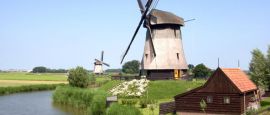Netherlands Food and Drink
'Typical' Dutch food tends to be wholesome and hearty, rather than elegant. Large towns, however, have a wide range of restaurants specialising in international dishes. In fact, The Netherlands boasts with more than 100 Michelin-starred restaurants. Indonesian cuisine, a spicy legacy of Dutch colonisation in the East Indies, is particularly good in the Netherlands.
A Dutch breakfast usually consists of fresh bread, cheese, sausage, butter and hagelslag (chocolate sprinkles), jam and often a boiled egg, along with a cup of strong coffee. Lunch is a rapid affair, such as broodjes (sandwiches). Dinner, eaten between 1800 and 1900, is a more substantial meal, usually some combination of meat or fish with potatoes and veggies. Holland is famous for its cheeses, available in jonge (young), belegen (mature) and oude (old) versions; the last tends to be the crumbliest and earthiest. Beer is good, with pilsener-style lagers the most popular. Jenever, aka Dutch gin, flavored with juniper berries and served chilled, is usually knocked back in a single go.
• Vlaamse frites (French fries, though literally translated as Flemish fries) is a popular snack, customarily served with a gob of mayonnaise, though curry or peanut sauce make more exciting toppings.
• Erwtensoep, thick pea soup flavored with sausage, makes a filling repast; some version of it is often served by the local pub in winter.
• Poffertjes - tiny pancakes often laced with Grand Marnier and dusted with confectioners sugar--are a teatime favourite.
• Herring fillets are widely available from street stalls and accompanied by pickles and onions; smoked eel (gerookte paling) is another seafood speciality.
• Stamppot is a hearty, traditional mash-up of potatoes with endive, turnips or some other earthy vegetable, customarily accompanied by smoked sausage.
All hotels and restaurants include 15% service and VAT. It is customary to leave small change when paying a bill.
Coffee, tea, chocolate and fruit juice are drunk at breakfast. The local spirit is jenever (Dutch gin), normally taken straight and chilled as a chaser with a glass of beer, but it is sometimes drunk with mixers. It is available in numerous flavours.
The most popular beer brands in Amsterdam are Amstel and the ubiquitous Heineken, which is also produced in the city. There are also a number of smaller breweries producing specialist beers and ales for the connoisseur, including the Trappist Brouwerij De Koeningshoeven. Dutch liqueurs are excellent and include Curaçao, Parfait d'Amour, Triple Sec (similar to Cointreau) and Dutch-made versions of crème de menthe, apricot brandy and anisette.
Do you have any Feedback about this page?
© 2025 Columbus Travel Media Ltd. All rights reserved. No part of this site may be reproduced without our written permission, click here for information on Columbus Content Solutions.



 You know where
You know where